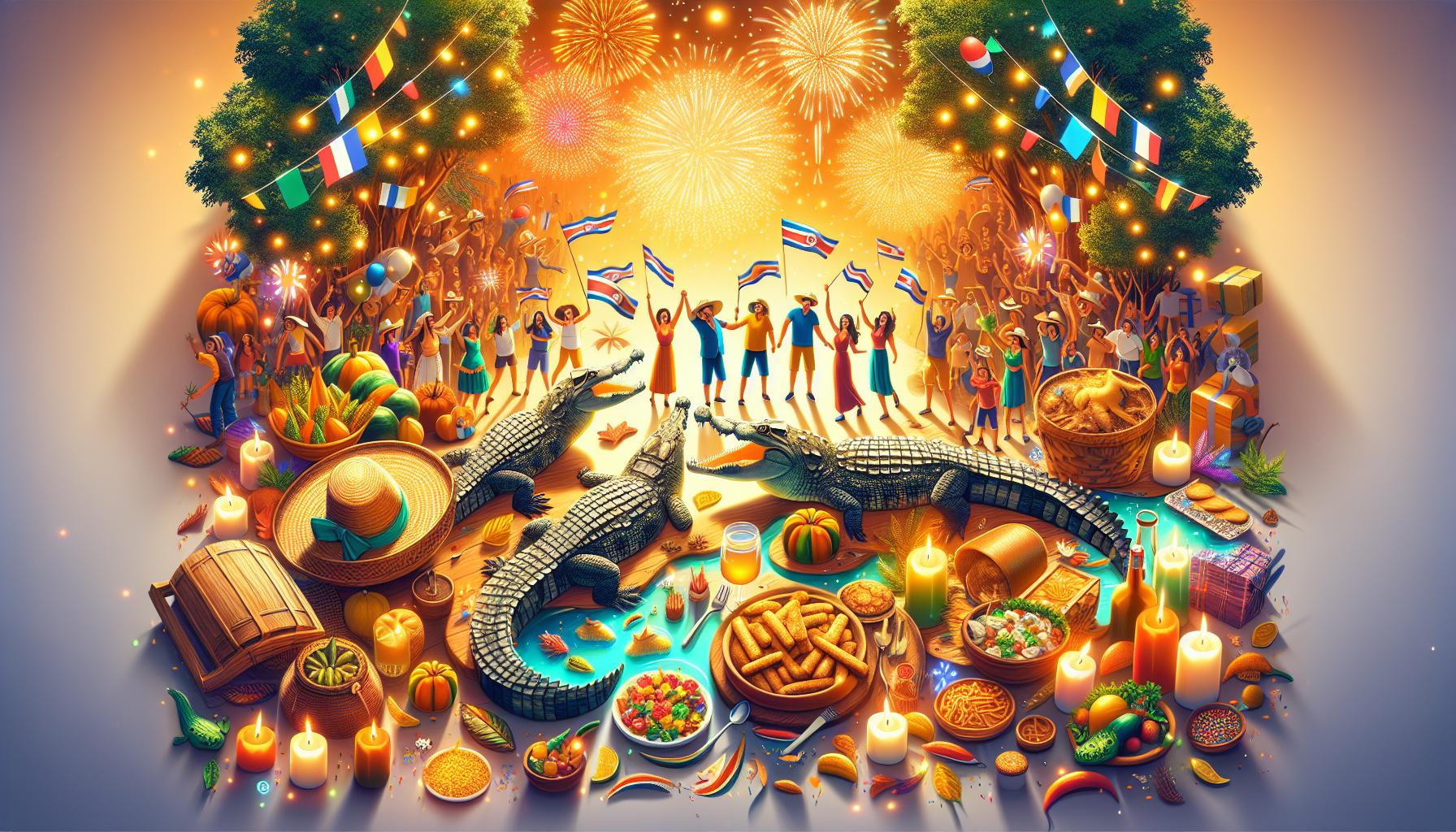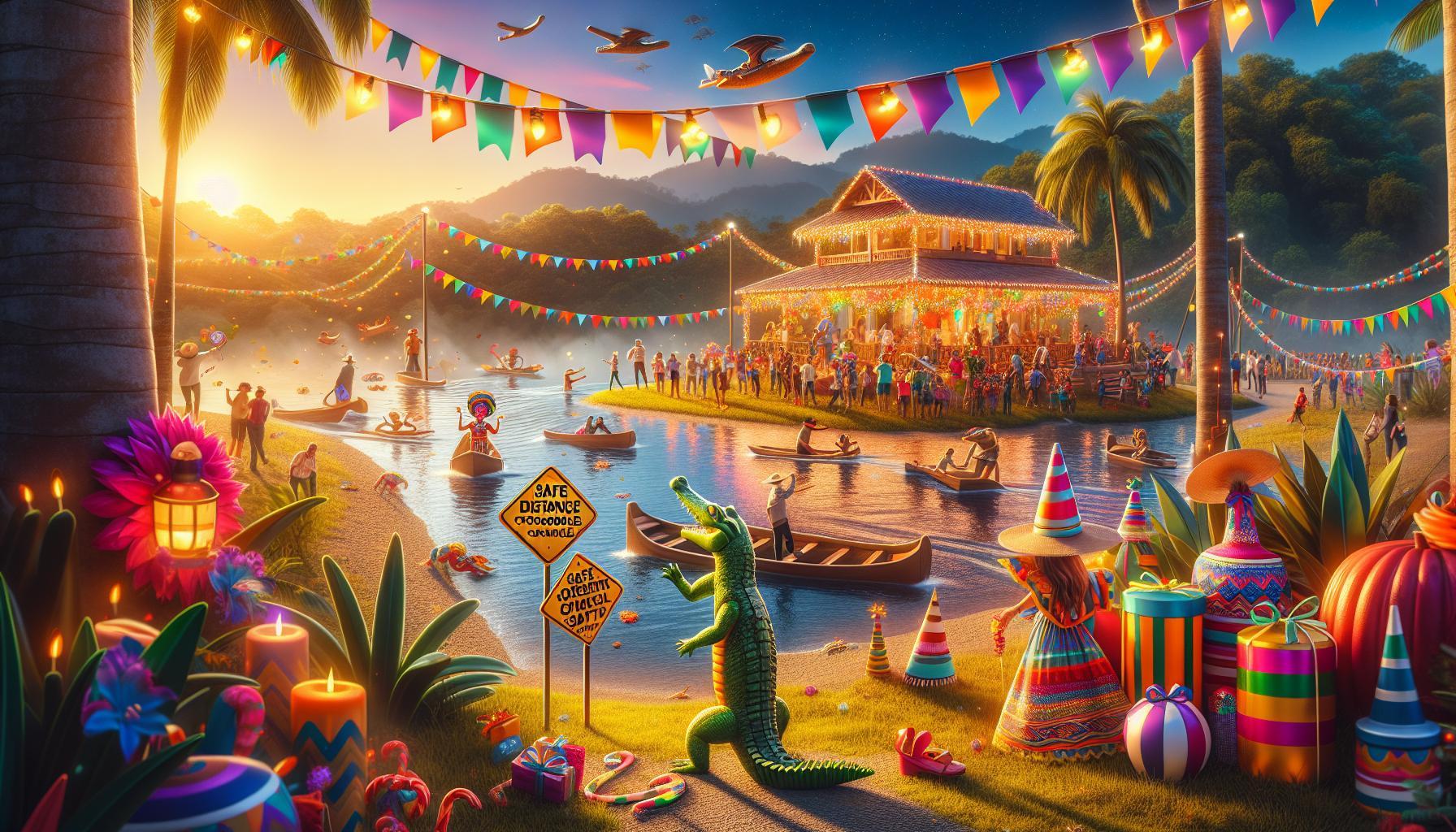Costa Rica’s stunning landscapes are home to a diverse array of wildlife, including formidable crocodiles. Understanding where these reptiles can be found and how to safely coexist with them is essential for both locals and visitors. This guide will help you navigate the rich ecosystems of Costa Rica while staying safe around these ancient predators.
Understanding Crocodile Habitats in Costa Rica: A Closer Look

The lush landscapes of Costa Rica provide a thriving environment for various wildlife, including two primary species of crocodilians: the American crocodile (*Crocodylus acutus*) and the spectacled caiman (*Caiman crocodilus*). One fascinating aspect of these reptiles is their adaptability to different aquatic habitats, which include rivers, estuaries, and mangrove swamps. Understanding where these creatures live is crucial for both wildlife enthusiasts and individuals interested in reptile safety while exploring the natural wonders of this vibrant country.
Key Habitats of Crocodiles in Costa Rica
American crocodiles are commonly found along both the Pacific and Atlantic coasts, favoring lowland wetlands that provide ample opportunities for hunting and nesting. Some of the most notable locations include:
- Tarcoles River: Known for its large population of American crocodiles, the Tarcoles River, especially near the famous “Crocodile Bridge,” draws tourists and local visitors alike.
- Estuaries: These transitional areas where fresh and saltwater mix are ideal for crocodiles due to the abundance of prey and sheltered nesting sites.
- Mangrove Swamps: The intricate root systems of mangrove trees offer perfect hiding spots for crocodiles as they hunt for fish and other aquatic animals.
The spectacled caiman, while smaller than its American counterpart, thrives in many of the same habitats. They are often found in freshwater lakes and slow-moving rivers, where they can camouflage in the dense vegetation lining the shores.
An Overview of Their Distribution
Crocodiles are not limited to any single area in Costa Rica; they are spread throughout various ecosystems. The table below highlights the key species and their common habitats:
| Species | Common Habitat |
|---|---|
| American Crocodile (*Crocodylus acutus*) | Rivers, estuaries, coastal mangroves |
| Spectacled Caiman (*Caiman crocodilus*) | Freshwater lakes, slow rivers, wetlands |
Recognizing these habitats can enhance your experience while exploring Costa Rica. Tourists are encouraged to observe crocodiles from a safe distance and to respect these formidable creatures in their natural environments. By understanding where crocodiles reside, visitors can appreciate their role in the ecosystem and promote safety while enjoying the beauty of Costa Rica’s diverse wildlife. Remember, knowledge is key to both enjoyment and safety in the wild spaces of this stunning country.
Common Locations to Spot Crocodiles: Tips for Safe Viewing

Crocodiles are one of the most intriguing wildlife attractions in Costa Rica, with their majestic and formidable presence in various ecosystems across the country. If you’re a wildlife enthusiast or just looking to get a closer view of these fascinating reptiles, several prime locations provide optimal viewing opportunities while adhering to safety guidelines. Engaging with Costa Rica’s rich biodiversity, especially its crocodiles, can be both thrilling and educational.
Top Spots for Crocodile Viewing
The Tarcoles River stands out as one of the best places to spot American crocodiles, known for harboring some of the largest crocodile populations in the world. This river is conveniently located near San Jose, making it an accessible destination for tourists and wildlife lovers alike. Visitors often gather on the famous crocodile bridge over the Tarcoles, a safe vantage point that offers breathtaking views of these creatures basking in the sun or gliding through the water.
Another excellent location is the Crocodile Bridge, officially known as the highway bridge on the Carretera Pacífica Fernández Oreamuno. This site provides free access and is an incredibly popular spot for photographers and nature watchers. Not only can you see crocodiles here, but you might also catch a glimpse of other wildlife in the surrounding mangroves.
Safety Tips for Viewing
While the allure of seeing these magnificent reptiles is strong, safety should always be a priority. Here are some tips to ensure a safe and enjoyable crocodile-viewing experience:
- Keep a Safe Distance: Always maintain a safe distance from the water’s edge, as crocodiles can be unpredictable and quick.
- Follow Local Guidelines: Respect any signage and guidance provided by local authorities. It may indicate safe viewing areas or necessary precautions.
- Do Not Feed the Crocodiles: Feeding these animals can encourage dangerous behaviors and is illegal in many areas.
- Watch Children Closely: Ensure that children stay back from the water’s edge and are supervised at all times.
Understanding the habitat and behavior of crocodiles will enhance your viewing experience. Engage responsibly with the environment while observing these incredible reptiles, and remember that respecting their natural habitat is crucial for conservation efforts and personal safety. Whether you’re visiting the Tarcoles River or the Crocodile Bridge, these guidelines from the “Does Costa Rica Have Crocodiles: Reptile Safety Guide” will help you appreciate these fascinating creatures while staying safe.
How to Stay Safe: Practical Guidelines for Encountering Costa Rica’s Crocs
Crocodiles are fascinating creatures that draw many visitors to the rivers and estuaries of Costa Rica. However, their presence also demands respect and caution. Encountering these reptiles can be thrilling, but safety should always be your top priority. By following a few practical guidelines, you can enjoy your wildlife experiences without putting yourself at risk.
Understanding Their Habitat
Crocodiles in Costa Rica can commonly be found in locations such as the Rio Tarcoles, known for having a significant population. They inhabit both the Pacific and Caribbean coasts, thriving in estuaries, rivers, and lagoons. Familiarizing yourself with these habitats is essential. Always keep a safe distance from the water’s edge, as crocodiles can be surprisingly quick on land and in water.
Safety Precautions
When you are exploring crocodile habitats or participating in guided tours, adhere to these safety guidelines:
- Stay at a Distance: Maintain a safe distance of at least 30 feet from the water. Crocodiles are known for their stealth and can strike swiftly.
- Avoid Feeding: Never attempt to feed crocodiles, as this can alter their natural behavior and increase the risk of an aggressive encounter.
- Keep Pets Leashed: Pets can unknowingly provoke crocodiles. Keep dogs on leashes or avoid bringing them to crocodile-infested areas entirely.
- Stay on Designated Paths: When walking near known crocodile areas, stick to marked trails and platforms to avoid unexpected encounters.
Be Aware of Your Surroundings
Always remain vigilant. Look for warning signs indicating the presence of crocodiles and listen to local advice. When engaging in activities such as kayaking or fishing, stay alert and keep your boat or equipment at a safe distance from the shores. Sunset and sunrise are common feeding times for crocodiles, so exercise extra caution if you’re near the water during these times.
By understanding the ecosystem and respecting the boundaries of these powerful reptiles, you can safely experience the stunning wildlife Costa Rica has to offer. Always prioritize safety to ensure your adventures remain memorable for the right reasons.
The Role of Crocodiles in Costa Rica’s Ecosystem: Why They Matter

Crocodiles play a vital role in the ecosystems of Costa Rica, contributing to the balance and health of their habitats. These ancient reptiles are not just apex predators; they help maintain the populations of various species, which in turn supports the ecological tapestry of the regions they inhabit. In Costa Rica, two notable species thrive: the American crocodile and the saltwater crocodile. Their presence signals a healthy ecosystem, as they often reside in brackish and freshwater environments like rivers, mangroves, and coastal areas.
Key Ecological Contributions
One of the critical roles crocodiles serve is as both predators and scavengers. They regulate populations of prey species, from fish to terrestrial animals, thereby sustaining the harmony of the food web. This predation helps to prevent overpopulation, which could lead to habitat degradation. Additionally, when crocodiles scavenge on carrion, they help reduce disease by breaking down and consuming decaying matter. This not only cleans the environment but also recycles nutrients into the ecosystem.
- Apex Predators: Control the population of various species.
- Scavengers: Clean the environment by consuming carrion.
- Habitat Maintenance: Influence the structure of their habitats by creating openings that facilitate growth for other organisms.
Beyond their immediate ecological roles, crocodiles also have significant impacts on their surroundings. Their nesting behaviors contribute to nutrient cycling, while their presence in specific environments assists in maintaining the health of aquatic systems. For instance, the nesting areas they create along riverbanks and coastal zones provide crucial habitats for many other species, including birds and small mammals.
Conservation Efforts
Due to the threats posed by climate change, habitat destruction, and pollution—such as that seen in the Tarcoles River—the conservation of crocodiles has become increasingly important. These reptiles are now a focal point in various conservation programs aimed at preserving their populations and the habitats they rely on. Responsible tourism, such as visiting natural habitats and observing these creatures safely, can also contribute to ongoing efforts in their protection.
In conclusion, understanding the roles that crocodiles play in ecosystems helps reinforce the importance of their conservation. Protecting these magnificent creatures ensures the stability of the broader environmental systems they inhabit, which aligns with the principles outlined in resources like the “Does Costa Rica Have Crocodiles: Reptile Safety Guide.” By appreciating the intricate connections within nature, we can better advocate for the preservation of biodiversity in Costa Rica.
Misconceptions About Crocodiles: Debunking Myths and Fears
Crocodiles often evoke a mix of fascination and fear, leading to a number of misconceptions that can cloud public understanding of these remarkable creatures. One prevalent myth is that all crocodiles are aggressive and pose an immediate threat to humans. While it’s true that American crocodiles, such as those found in Costa Rica, can be dangerous if provoked, they are generally not aggressive towards humans unless they feel threatened or their territory is encroached upon. Awareness and respect for their space can significantly reduce risks during encounters.
Myth vs. Reality
Another common misconception is the belief that all crocodiles are equally large and destructive. In reality, species like caimans, often mistaken for crocodiles, are much smaller and exhibit different behaviors. They have a broader snout and a preference for freshwater habitats, allowing for a diverse range of crocodilian interactions within ecosystems in Costa Rica. Understanding these distinctions helps cultivate a more thoughtful approach to crocodile conservation and safety.
- Myth: All crocodiles will attack humans.
- Reality: Crocodiles typically avoid human interaction unless they feel threatened.
- Myth: Crocodiles are all the same size and species.
- Reality: Costa Rica is home to various species, including smaller caimans.
Importance of Education
Education plays a crucial role in dispelling these myths. Providing tourists and locals with accurate information about crocodile behavior can foster respect and understanding, leading to safer interactions. For instance, when visiting areas like the Tárcoles River, where crocodile populations are dense, awareness of their habitat and natural behaviors can help prevent accidents. Engaging in responsible wildlife viewing practices, such as maintaining a safe distance and avoiding feeding the reptiles, not only enhances safety but also promotes conservation efforts.
In summation, debunking myths about crocodiles is essential for coexistence. By understanding their true nature and respecting their habitats, both humans and crocodiles can thrive in Costa Rica’s rich biodiversity, making it a rewarding experience for all.
Engaging with Nature: Responsible Wildlife Observation Practices
Observing wildlife in their natural habitats can be one of the most exhilarating experiences, particularly in biodiverse countries like Costa Rica, which is home to majestic crocodiles. Engaging with such powerful reptiles requires a commitment to responsible observation practices that ensure both the safety of the observer and the well-being of the animals. Understanding how to ethically interact with these creatures, especially in sensitive environments, is critical not only for personal safety but also for the conservation of wildlife.
The Importance of Maintaining Distance
One of the fundamental best practices when observing crocodiles and other wildlife is to maintain a safe distance. Getting too close can cause unnecessary stress to the animal, alter their natural behaviors, and increase their vulnerability. Utilize tools such as binoculars or spotting scopes to enjoy the spectacle without encroaching on their space. This approach is not just respectful to the animals but also enhances your own experience, providing a better view while ensuring their comfort and safety.
Respecting Habitats
Another key aspect of responsible wildlife observation is respecting the habitats where these creatures live. Specific areas may be critical for nesting, breeding, or feeding. Avoid disturbing these sites—such as riverbanks or wetlands—which are crucial for the survival of reptiles like crocodiles. Pay attention to any signs indicating restricted access areas and be mindful of your impact on the environment, ensuring that you leave no trace behind. By supporting ethical wildlife watching practices, you contribute to the protection of natural ecosystems and help sustain local communities that rely on these environments.
Choosing Ethical Experiences
Selecting responsible tour operators can lead to a more meaningful wildlife observation experience. Research and read reviews to find companies committed to ethical practices that respect wildlife and their habitats. This not only enhances your adventure but also promotes conservation efforts that ensure future generations can enjoy similar encounters. Responsible operators will often provide guidelines on observing crocodiles safely, enhancing your knowledge and appreciation of these incredible creatures.
With these practices in mind, you can responsibly enjoy the thrill of watching crocodiles in Costa Rica, cultivating a deeper connection with the natural world while playing a part in its preservation.
Local Legends and Stories: Crocodiles in Costa Rican Culture
Costa Rica is not just a haven for biodiversity; it is also rich in culture and folklore that intertwines with its natural inhabitants, particularly crocodiles. These formidable reptiles are steeped in local legends that reveal both the reverence and caution with which the locals regard them. In various regions of the country, crocodiles are considered powerful symbols, often associated with myths that speak to their role in the ecosystem and the community.
Crocodiles in Mythology and Folklore
Local stories often depict crocodiles as protectors of the waterways, embodying the spirit of the rivers they inhabit. Many Costa Ricans believe that respecting these creatures is essential for maintaining balance within nature. Legends suggest that disturbing a crocodile’s territory could lead to misfortunes, such as floods or droughts, which underscores the respect locals have for these creatures. This reverence is especially pronounced in areas like the Tarcoles River, renowned for its large population of saltwater crocodiles, where local guides emphasize the need for caution and respect when observing them in their natural habitat.
Symbolism and Cultural Significance
Crocodiles serve as an important cultural symbol, represented in various forms of art and storytelling. They are often portrayed as powerful guardians in indigenous folklore, with tales highlighting their intelligence and strength. For example, certain stories recount how the crocodile made pacts with other animals, embodying themes of cooperation and survival. This cultural imagery not only enriches local identity but also serves as a reminder of the ecological importance of crocodiles within Costa Rica’s diverse ecosystems.
Practical Implications for Visitors
For those exploring the crocodile-laden areas of Costa Rica, engaging with these local legends offers deeper insight into the human-animal relationship. Visitors are encouraged to:
- Learn about local conservation efforts that aim to protect crocodile habitats.
- Participate in guided tours that promote safe viewing practices and educate about crocodile behavior and ecology.
- Respect the natural territory of these reptiles by adhering to any safety guidelines provided by local authorities or guides.
Understanding these connections enhances the experience and fosters a greater appreciation for the majestic crocodiles that roam the rivers of Costa Rica.
As new stories continue to emerge, they reinforce the connection between culture and nature, amplifying the message found in the ‘Does Costa Rica Have Crocodiles: Reptile Safety Guide’ — knowledge and respect are key when sharing this beautiful habitat with its ancient dwellers.
Family Adventures: Enjoying Nature Safely with Kids in Crocodile Areas
Did you know that Costa Rica is home to several species of crocodiles, making it essential for families exploring this beautiful country to understand how to navigate crocodile habitats safely? With their natural curiosity, kids can be drawn to water, where these formidable reptiles often reside. To provide a memorable and safe family adventure, it’s crucial to equip yourself and your children with the knowledge necessary to enjoy nature responsibly.
Tips for Safe Exploration
When venturing into areas known for crocodile populations, consider the following safety measures:
- Stay Within Designated Areas: Always stick to marked trails and designated viewing platforms when observing wildlife. This reduces the risk of an unexpected encounter.
- Supervise Children Closely: Keep a watchful eye on younger family members, especially when near bodies of water. Establish clear boundaries and explain the importance of staying away from the water’s edge.
- Educate Before You Go: Teach your kids about crocodile behavior using engaging materials. Discuss what to do if they spot a crocodile and instill respect and caution for wildlife.
- Choose the Right Time for Activities: Dawn and dusk are peak times for crocodile activity. Plan your outdoor adventures during daylight to minimize encounters.
Real-World Examples of Safety Practices
In Costa Rica, wildlife tours often emphasize the significance of crocodilian safety awareness. For example, many tour guides will provide briefings on staying safe around the rivers where crocodiles are commonly spotted. These guides might share stories of previous tours, underlining the importance of adhering to safety instructions. By participating in these educational experiences, families can learn firsthand how to respect and observe crocodiles from a safe distance.
Making Memories Safely
Engaging with nature in crocodile-rich regions can be thrilling, but it should always come with precautions. Families can enjoy activities such as kayaking or wildlife watching by opting for reputable guides who prioritize safety and knowledge. This way, you can create lasting memories in stunning settings while ensuring the safety of your loved ones. Understanding how to respect and navigate habitats inhabited by crocodiles, as highlighted in resources like the Reptile Safety Guide, fosters a more rewarding family adventure.
By incorporating these strategies into your travel plans, you’re not only ensuring your family’s safety but also enhancing their appreciation for the incredible wildlife that Costa Rica has to offer.
Frequently Asked Questions
Does Costa Rica have crocodiles?
Yes, Costa Rica is home to several species of crocodiles, predominantly the American crocodile, which can be found in various waterways across the country. These reptiles thrive in the warm climate and diverse ecosystems.
The American crocodile can often be spotted in rivers, lagoons, and coastal areas. Locations like the Tarcoles River are particularly famous for their large crocodile populations, attracting both tourists and wildlife enthusiasts. It’s important to be aware of their presence if you’re exploring natural waterways.
What should I do if I encounter a crocodile?
If you encounter a crocodile, keep your distance and never approach or feed them. These animals can be dangerous, and maintaining a safe space is crucial for your safety.
When near water, always stay vigilant and watch for warning signs of crocodiles, such as their distinctive eyes and snouts. Remember, swimming in areas known for crocodile activity should be avoided to prevent any accidents.
How common are crocodile attacks in Costa Rica?
Crocodile attacks in Costa Rica are rare but can happen. On average, a few attacks are reported each year, with some being fatal. It’s essential to understand the risks involved in visiting areas where crocodiles are present.
Visitors should exercise caution, especially near waterways. Understanding natural habitats and recognizing the signs of crocodile activity can greatly reduce the risk of an encounter. For more details, consider checking out resources on wildlife safety in the region.
Where are the best places to see crocodiles safely?
Some of the best places to see crocodiles safely include the Tarcoles River, where tourists can observe them from guided boat tours. These excursions allow for safe viewing while maintaining a respectful distance.
Guided tours often provide insights into the behavior and ecology of crocodiles, enhancing the experience. Always choose reputable tour operators who emphasize safety and conservation to ensure an enriching visit.
Can I swim in rivers where crocodiles are present?
Swimming in rivers known to have crocodiles is highly discouraged due to potential dangers. Crocodiles can be unpredictable, especially in their natural habitats.
Even if the water looks inviting, the risk of an unexpected encounter is significant. Opt for designated swimming areas that are monitored for safety instead.
Why are crocodiles important to the ecosystem in Costa Rica?
Crocodiles play a critical role in maintaining the balance of their ecosystems. As apex predators, they help control populations of various species and contribute to the health of aquatic environments.
By regulating fish populations and facilitating nutrient cycling, crocodiles help ensure the overall stability of their habitats. Understanding their ecological impact highlights the importance of crocodile conservation efforts in Costa Rica.
What safety precautions should I take around crocodiles?
To stay safe around crocodiles, always adhere to warning signs and avoid areas marked as crocodile habitats. Stay a safe distance from the water’s edge and never attempt to feed them.
Additionally, educating yourself about crocodile behavior can help you recognize signs of danger. When exploring areas known for crocodiles, it’s wise to travel in groups and follow local guidelines.
Are there laws protecting crocodiles in Costa Rica?
Yes, crocodiles are protected by law in Costa Rica, and harming or disturbing them can lead to legal consequences. These protections reflect the country’s commitment to wildlife conservation.
Efforts to protect crocodiles often include habitat preservation initiatives, which are vital for their survival. Engaging with local conservation programs can be a great way to learn more and support these efforts.
In Conclusion
As you embark on your adventure through the lush landscapes of Costa Rica, you’ll find yourself in the company of fascinating reptiles—particularly crocodiles and caimans. From the eerie calls echoing across the Rio Tarcoles to the sun-soaked estuaries where these magnificent creatures bask, it’s a wildlife experience unlike any other.
Imagine standing on a bridge overlooking the famed Tarcoles River, the air thick with excitement as you glimpse the American crocodile gliding through the water below. Local guides share stories of their encounters: “I once saw a mother croc protect her hatchlings right there!” they say, eyes sparkling with the thrill of nature’s raw beauty. These narratives are woven into the very fabric of Costa Rican culture, where respect for wildlife runs deep.
However, safety remains paramount. Understanding how to safely observe these majestic reptiles while respecting their habitats can enhance your journey immensely. Align your actions with eco-responsibility, and you’ll not only savor every moment but also contribute to the conservation of these stunning species.
As you prepare for your Costa Rican journey, let curiosity be your compass. Whether you’re an adventure seeker, a family exploring nature, or an expat considering a new life abroad, the call of Costa Rica’s rich biodiversity awaits. Dive deeper into the fascinating world of crocodiles while learning to navigate their habitats responsibly. Your adventure is just beginning—embrace the thrill and let the wonders of Costa Rica inspire your journey!






